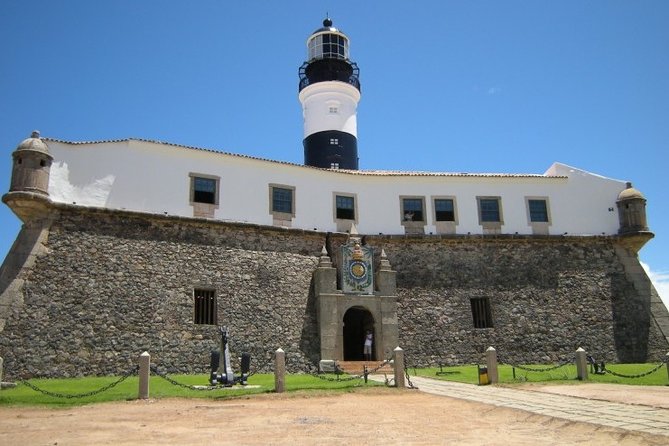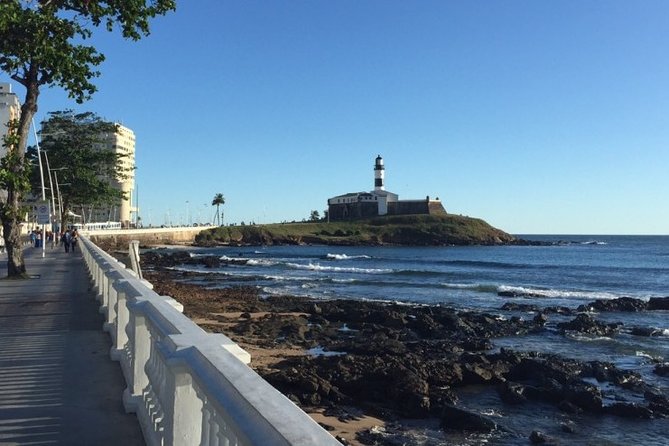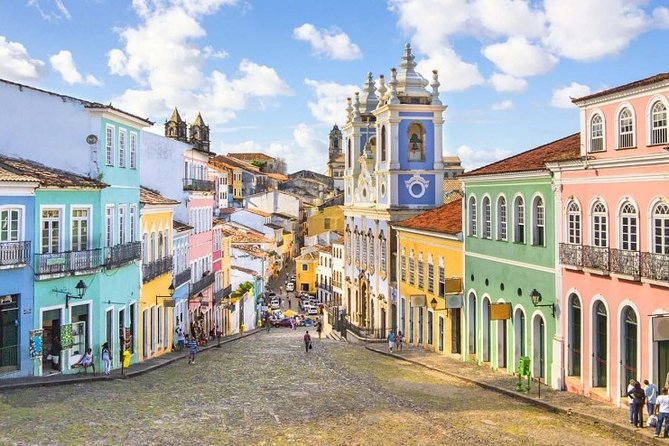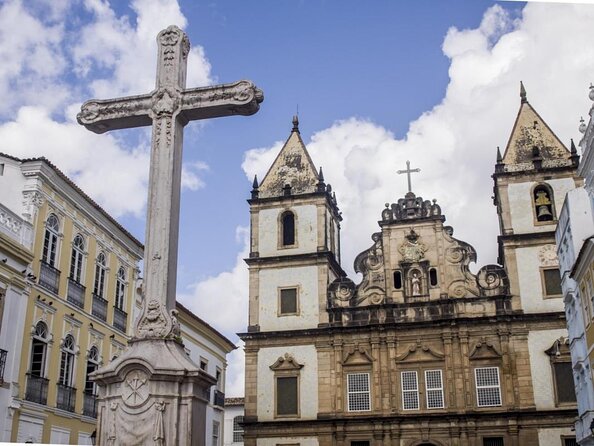Situated on Brazil’s northeast coast, the historical region of Bahia is a captivating blend of colonial heritage and cultural richness. Anchored by the UNESCO-listed Pelourinho neighborhood, Bahia’s architectural gems like the ornate São Francisco Church showcase its Baroque influences. Beyond its striking visuals, the area’s Afro-Brazilian music, Candomblé rituals, and renowned cuisine reflect the diverse legacies that have shaped this vibrant destination. Delving into Bahia’s storied past offers a glimpse into the intricate tapestry that makes it a quintessential Brazilian experience.
Key Points

- Salvador da Bahia’s historic Pelourinho neighborhood is a UNESCO World Heritage site featuring colorful colonial architecture and cobblestone streets.
- The Baroque architecture of churches like São Francisco Church showcases the religious fervor of Portuguese colonizers in the region.
- Afro-Brazilian cultural practices, such as Candomblé rituals and the martial art-dance of capoeira, are deeply rooted in Bahia’s history.
- Renowned Brazilian author Jorge Amado immortalized the sights and sounds of Bahia in his celebrated novels, contributing to the region’s rich literary legacy.
- Bahia’s diverse cuisine reflects the blending of African, Portuguese, and indigenous influences, offering a unique gastronomic experience.
Salvador Da Bahia’s Historical Landmarks

Salvador da Bahia, the vibrant capital of Brazil’s Bahia state, proudly showcases an array of captivating historical landmarks that transport visitors back in time.
The iconic Pelourinho neighborhood, a UNESCO World Heritage site, boasts colorful colonial architecture, cobblestone streets, and the magnificent São Francisco Church, renowned for its ornate Baroque interior.
Another must-see is the Farol da Barra, a historic lighthouse perched at the tip of the Barra peninsula, offering panoramic views of the city and the sparkling Atlantic Ocean.
The Casa de Jorge Amado, the former home of the celebrated Brazilian author, provides a glimpse into the literary heritage of the region.
These treasures offer a window into Bahia’s rich cultural legacy.
Fascinated by Salvador da Bahia's past? More historical tours we've covered
Exploring Bahia’s Vibrant Culture

Beyond Bahia’s captivating historical landmarks, the region’s vibrant culture permeates every aspect of daily life, from the rhythmic beats of traditional music to the vibrant celebrations that pulse through its streets. The state’s rich cultural heritage is showcased in its thriving arts scene, vibrant festivals, and diverse culinary delights. Explore the following table to learn more about Bahia’s vibrant culture:
| Cultural Highlight | Description |
|---|---|
| Afro-Brazilian Music | Rhythmic beats of samba, capoeira, and other traditional music forms |
| Candomblé Rituals | Afro-Brazilian religious practices with roots in West African traditions |
| Capoeira Demonstrations | Martial art-dance hybrid with acrobatic movements and cultural significance |
| Colorful Festivals | Lively celebrations like Carnival, with music, costumes, and community spirit |
| Diverse Cuisine | Flavorful dishes blending African, Portuguese, and indigenous influences |
Architectural Gems of Old Bahia
Dotting the historic streets of Old Bahia, an array of architectural gems showcase the region’s rich cultural tapestry, blending Portuguese, African, and indigenous influences.
From the grand Baroque churches to the colorful colonial houses, each structure tells a story of Bahia’s diverse heritage.
The Igreja de São Francisco, with its gilded interior and intricate façade, stands as a testament to the Portuguese colonizers’ religious fervor.
Nearby, the Casa do Comércio exemplifies the region’s mercantile past, its elegant neoclassical design a reflection of Bahia’s prosperous trading history.
These architectural masterpieces invite visitors to enjoy Bahia’s captivating past, offering a glimpse into the vibrant cultural mosaic that defines this enchanting corner of Brazil.
Discovering Bahia’s Religious Heritage
Bahia’s rich religious heritage is showcased through its numerous sacred sites, each imbued with captivating histories and architectural splendor.
From the iconic Bonfim Church, known for its vibrant Baroque exterior and annual pilgrimages, to the serene Nosso Senhor do Bonfim Church, which blends Catholic and Candomblé traditions, these holy spaces offer a glimpse into the region’s diverse spiritual tapestry.
Additionally:
-
The Sé Cathedral, a towering 16th-century structure, stands as a testament to Bahia’s Portuguese colonial roots.
-
The Church of São Francisco, renowned for its exquisite gold-leafed interior, exemplifies the extravagance of colonial religious architecture.
-
The Senhor do Bonfim Basilica, a pilgrimage site famous for its colorful ribbons, connects Bahia’s Catholic and Afro-Brazilian religious practices.
Gastronomy and Culinary Delights

Alongside Bahia’s rich religious heritage, the region’s vibrant culinary scene captivates visitors, offering a tantalizing array of traditional dishes that reflect the area’s diverse cultural influences.
From the renowned acarajé – a savory black-eyed pea fritter – to the moqueca, a coconut-based seafood stew, Bahian cuisine showcases the harmonious blend of African, Portuguese, and indigenous flavors.
Visitors can enjoy the lively markets, sampling local produce, spices, and artisanal treats.
The iconic maniçoba, a slow-cooked cassava leaf stew, and the sweet cocada, a coconut candy, are must-try delicacies that tantalize the palate.
Gastronomy is an integral part of Bahia’s rich cultural tapestry, offering visitors a delicious window into the region’s heritage.
Salvador, the vibrant capital of Bahia, comprises a tapestry of distinct neighborhoods, each offering visitors a unique glimpse into the region’s cultural heritage.
From the colonial splendor of the Pelourinho to the bustling Mercado Modelo, these diverse enclaves invite travelers to enjoy Bahia’s rich history and contemporary allure.
Navigating the neighborhoods of Bahia allows visitors to:
-
Explore the well-preserved colonial architecture and lively plazas of Pelourinho.
-
Discover the vibrant arts and crafts scene at the Mercado Modelo.
-
Experience the lively Afro-Brazilian culture and traditions that permeate the city’s streets.
Bahia’s Artistic and Literary Legacies
Beyond the vibrant neighborhoods, Bahia’s rich artistic and literary traditions have left an indelible mark on the region’s cultural landscape.
From the iconic works of Jorge Amado to the captivating murals that adorn the streets, the state’s creative legacies offer visitors a deeper understanding of its heritage.
Amado, one of Brazil’s most renowned authors, has immortalized the sights and sounds of Bahia in his novels, which have been celebrated worldwide.
Similarly, the colorful, large-scale murals found throughout Salvador showcase the area’s Afro-Brazilian influences and vibrant spirit.
Through these artistic expressions, travelers can enjoy Bahia’s vibrant cultural tapestry, gaining a newfound appreciation for its enduring artistic legacy.
Practical Tips for Visiting Bahia

Preparing for a visit to Bahia involves considering a few practical tips to make the most of one’s time in this captivating Brazilian state. Arranging transportation, understanding the local currency, and familiarizing oneself with the region’s climate and attire can all contribute to a seamless and enjoyable experience.
Here are three key considerations when planning a trip to Bahia:
-
Transportation: Utilizing local buses, taxis, or ride-sharing services can be an efficient way to navigate the region’s cities and attractions.
-
Currency: Becoming familiar with the Brazilian real and ensuring access to funds can help avoid hassles during the trip.
-
Clothing: Packing lightweight, breathable attire suitable for Bahia’s warm, tropical climate can enhance comfort and allow for easy exploration.
Frequently Asked Questions
What Is the Group Size for This Tour?
The tour has a maximum group size of 49 travelers. According to the tour overview, the tour is operated by ALLTOUR and can accommodate up to 49 participants on each excursion.
Is There a Minimum Age Requirement for Participants?
There is no minimum age requirement for participants on this tour. Infants must sit on laps, and most travelers can participate, according to the tour information provided.
Are Any Meals or Refreshments Included in the Tour?
The tour does not include any meals or refreshments. Participants are responsible for their own food and drinks during the tour. The tour price only covers the air-conditioned transportation and the services of a tour guide.
Can I Arrange for a Private or Customized Tour?
Yes, customers can arrange for a private or customized tour. ALLTOUR offers flexible booking options, allowing travelers to tailor the experience to their preferences and group size. Additional fees may apply for private or customized tours.
Are There Any Discounts Available for Students or Seniors?
Yes, the tour operator offers discounted rates for students and seniors. Customers can inquire about these discounts when booking the tour. The discounts may vary, so it’s best to check with the operator for the latest pricing details.
Recap
Bahia’s rich cultural heritage is a captivating blend of colonial influences and Afro-Brazilian traditions.
Its historic landmarks, vibrant arts, and flavorful cuisine invite visitors to enjoy the region’s unique tapestry.
From the UNESCO-listed Pelourinho to the stunning Baroque architecture, Bahia offers a captivating glimpse into Brazil’s past and present, making it a must-visit destination for those seeking to explore the country’s diverse cultural identity.
More Historical Tours in Salvador da Bahia
- Ivan Bahia, Original Historic Salvador Da Bahia & Beaches Private Full Day-Tour
- Salvador Historical Tour
- Ivan Bahias TOP Waterfall & Recôncavo Cultural Heritage Day-Tour From Salvador
- Historical Panoramic Tour for up to 4 People
- Historical City Tour of Pelourinho and Panoramic City Tour
- Walking Tour Historic Pelourinho
More Tour Reviews in Salvador da Bahia
- Tivoli Ecoresort Private Transfer
- Salvador Deluxe Privat SUV City Daytour With Exquisit Lunch.
- Transfers: Airport, Hotels, Maritime Terminals, Bus Station.
- Costa De Sauipe Transfer – Private Executive Van
- The Capoeira Experience 1 Day All About Capoeira Engenho
- Candomblé: Religious,Social Focus and Community Visits
Not for you? Here's more things to do in Salvador da Bahia we have recnetly reviewed
- 4 Best Dining Experiences in Salvador Da Bahia
- 4 Best Dinner Tours in Salvador Da Bahia
- 9 Best Full-Day Tours in Salvador Da Bahia
- Best 4 Day Tours in Salvador Da Bahia
- 5 Best Lunch Experiences in Salvador Da Bahia
- Praia Do Forte and Guarajuba – Leaving Salvador
- Praia Do Forte With Guarajuba Beach – Day Trip From Salvador
- 4-Days Experience at Salvador De Bahia, Savour the Cultural Fusion – Brasil
- Panoramic Tour, Salvador, Bahia, Brazil
- Ivan Bahia, Recôncavo Baiano: Cachoeira & Coqueiros Including Mangrove Trip + Lunch
- Private Stand Up Paddle and Kayak Tour on the Imbassaí River
- CITY ESCAPE: Relax on Night in Paradies With Breakfast & Dinner
